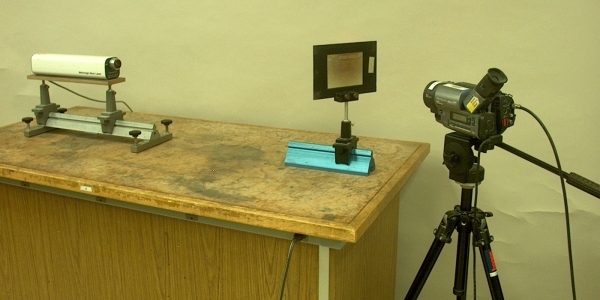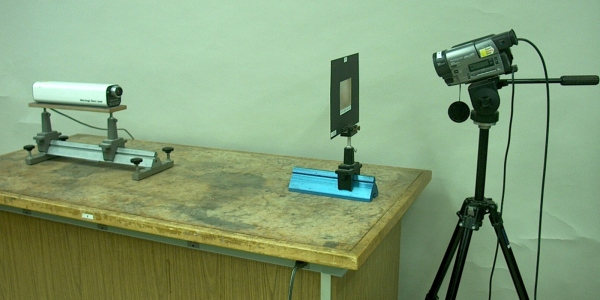 |
|
|
 |
 |
|
 |
|
|
 |
 |
|
In the photographs above (on the left), the expanded beam of a helium-neon laser is aimed at a (transmission) hologram. With the hologram set at the appropriate angle to the laser beam, when you view the hologram from the opposite side, you can see the reconstructed three-dimensional image of the objects whose image is encoded in the hologram. These are shown above on the right. You can place a video camera as shown in each photograph, to project the image to the class.
In 1948, Dennis Gabor introduced a new method for making images. This was published in Nature, 161(4098), 777 (1948). You can find a rather detailed development of the theory here (Proc. Royal Soc. London, 197(1051), 454 (1949)). At the time, he was looking for a way to improve the images formed by electron microscopes. With further developments by him and others, the field of holography was born. For his work in inventing holography, Gabor was awarded the 1971 Nobel Prize in Physics. You can read his Nobel address here, and find more information about him here.
The essence of holography is that if one illuminates an object with coherent light, the light reflected from different parts of the object bears specific phase relationships to the light that illuminates the object. There are several techniques for making a hologram, but the basic method is to use a laser to illuminate both the object and the film (or other recording medium) at the same time. One uses a beam expander so that the laser light illuminates the whole object and the film, and beamsplitters and mirrors to direct the illuminating beam (called the reference beam) to both the object and the film. Light reflected from the object meets light from the reference beam at the film, where it forms an interference pattern, the nature of which is determined by the phase relationships between the reference beam and the light reflected from all points on the object, at each point on the film. The film bearing this interference pattern is called a hologram, a word coined by Dennis Gabor (in the Proceedings of the Royal Society of London paper linked above). One can then reconstruct the image of the object by illuminating the film with a coherent light source.
An interesting aspect of holograms is the three-dimensional nature of the image. Not only do the objects have depth, but if you view the hologram from different positions, their orientation with respect to your line of sight changes. That is, if you view the holograms above from a point farther to the left, you see the groups of chess pieces from a different angle. In the top image, you move closer to the rook and farther from the queen, and the pawn moves toward the right of the bishop. In the bottom image, you move closer to the knight and farther from the bishop, and the pawn moves toward the right of the king. If you view from a point farther to the right, you move closer to the other side of the group (the queen in the top image, the bishop in the bottom image), and in the top image the pawn moves toward the left of the bishop, and in the bottom image the pawn moves toward the left of the king. You can demonstrate this to the class by moving the video camera to different positions.
Another interesting thing about holograms is that every part of the film contains information about the whole image. You can cut out a piece of the hologoram, and if you illuminate it with coherent light, you will see the whole image. It will be noisier than the image formed by the whole film, but it will be a complete image.
Holography has important practical applications. Holograms are used as security features on credit cards, ID cards, banknotes, checks and various other items, to prevent counterfeiting. A technique called holographic interferometry is widely used in industry for nondestructive testing. A hologram is made of an item under test. A failure in the structure of the item that causes even a subtle distortion of the surface, gives rise to interference rings or lines in the holographic image.
References:
1) There are many books and papers on holography. Dennis Gabor’s Nobel prize address gives an excellent review of the subject.
2) http://hyperphysics.phy-astr.gsu.edu/hbase/optmod/holog.html and links therein.